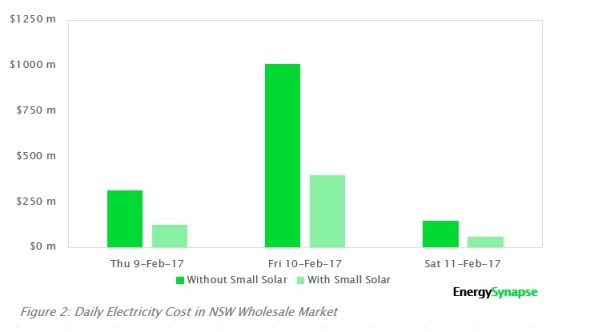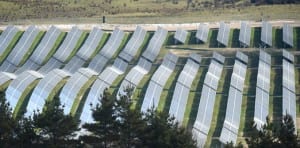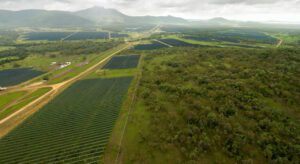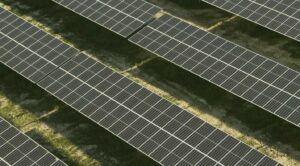An analysis of the big electricity price surges during the February heatwave in New South Wales suggests that rooftop solar on homes and businesses across the state likely reduced the market price of wholesale electricity by nearly $1 billion over three days.
The analysis by Marija Petkovic, of consulting firm Energy Synapse, says that without rooftop solar the total cost of market prices would have been $888 million higher, because peak demand during the heatwave, when temperatures soared to 45°C, would have been higher and longer.
Rooftop solar PV supplied only about 2 per cent of the state’s total power needs over that time – or about 17GWh – but its impact on the market was to cut the price of electricity by 60 per cent, delivering savings of $888 million.
Rooftop solar also likely delivered considerable savings in markets in Queensland and South Australia over the same period, although Petkovic says she has not crunched the numbers on those states, and there are many other factors to consider.
For example, given the huge amount of rooftop solar in Queensland – 1.72GW according to the Clean Energy regulator, more than the biggest coal-fired power station in the state – there would likely be another power station built if the rooftop solar wasn’t there.
Certainly though, the experience of the network owners and the grid operators in states like South Australia and Western Australia is that the high penetration of rooftop solar has done what Petkovic has identified in NSW – it has pushed the peak further into the evening, and reduced the breadth of it.
It also adds to the considerable benefits of rooftop solar during heatwaves, a time when Australia’s electricity networks are at their most vulnerable. While coal and gas plants in NSW, Queensland and South Australia tripped or failed to operate to capacity due to heat-related problems, rooftop solar performed exactly as expected.
So much so that the NSW government has said rooftop solar played a crucial role in keeping the lights on in the state, when the heatwave pushed the grid to its limits. Only the Tomago aluminium smelter had to suffer a forced outage.
The Petkovic analysis also highlights another issue with rooftop solar and the way it is compensated. Despite saving $888 million, the actual “market value” of the rooftop solar put into the grid was only around $9.6 million, or $550/MWh. Householders would have been lucky to receive 8c/kWh, or $80/MWh, for their output. Many would have received less.
This issue was highlighted in an earlier story “NSW rooftop solar saved the day but householders got paid a pittance”, quoting analyst Dylan McConnell, from Melbourne’s Climate and Energy College, who said rooftop solar clearly played a major role in reducing stress on the grids in Queensland and New South Wales, and kept a cap on prices. But got little reward.
So how did Petkovic arrive at her numbers? “The interesting question to me was how would the electricity market cope if there was no small solar?” she writes in a post on LinkedIn. “This is difficult to quantify, but my attempt considered three factors:
- What would electricity demand in NSW look like if the generation from small solar had to be met by the market. Data published by the Australian PV Institute was used for this analysis.
- Given this new demand profile, what would the 30 minute electricity price be in the wholesale market. To develop the likely set of prices without small solar, the 5 min bid stacks published by AEMO were examined for each period where small solar was generating power.
- What would be the cost to the market with small solar (i.e. the actual cost that was incurred) vs the cost without small solar (i.e. the estimate derived from 1 & 2).
This graph above shows the data for February 9 to 11. The light green shading shows the actual electricity demand that was seen by the market, while the dark green shading shows the estimated generation from small solar PV.
The effect of small solar on all three days was to reduce the length of peak demand and to push the peak to later in the afternoon.
So how much money would have been saved? The second graph shows the total electricity cost without small-scale solar (dark green) and the total electricity cost with small-scale solar (light green).
“Over the three-day period, small solar reduced the cost to the market by roughly $888 million,” Petkovic writes. “Even though small solar only covered 2 per cent of electricity demand, it cut the price of electricity by 60 per cent from an estimated volume weighted average price of $1920/MWh to $780/MWh.”
Could such figures be replicated in other states? Petkovic says possibly, but it is difficult to say if it would happen to the same extent.
“The issue with Queensland is that there is so much rooftop solar. If that solar wasn’t there, there would almost certainly be another generator in the market. This introduces significantly more uncertainty into the analysis and I wanted to be careful not to overstate the benefits.”
However, as we reported in February based on McConnell’s analysis, there is no doubt that rooftop solar delayed the peak in that state, and it wasn’t until rooftop solar started to wind down that the state’s gas generators were able to wield their market power, and push prices higher, as this graph shows.
The irony out of all this is that even though the network operators have admitted that rooftop solar narrows and delays the peak, they and the big retailers have fought against higher feed-in tariffs because they say the peak is not actually removed.
This sort of analysis underlines the benefits of rooftop solar. It is removing the ability of gas generators to set the price as high as they might otherwise, as well as providing perfectly reliable generation in the middle of the heatwave, when the fossil fuel generators were breaking under the stress of the heat. In short, they helped to keep the lights on.
In the meantime, the majority of solar households now on new “market” tariffs are receiving only the estimated average wholesale price of electricity over a year. That has meant a jump in NSW to between 11c and 14c/kWh, from July 1, and the inclusion of climate benefits with a defacto carbon price in Victoria.
But still, there are no network benefits – and only those households which are signed up with software providers such as Reposit, Redback and others, are able to tap into variations in market price.












